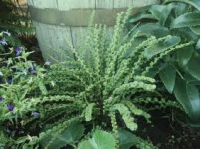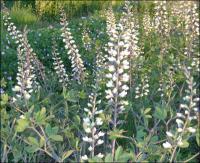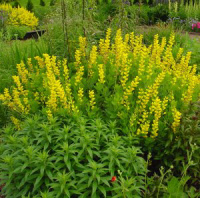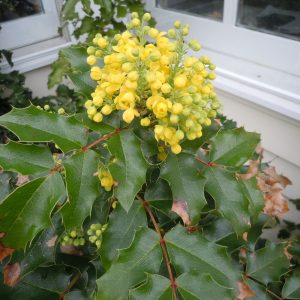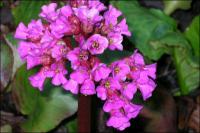Our Plants
Showing 81–88 of 587 results
-
Athyrium filix-femina Lady fern Z 3-8
Clumping fern with lance-shaped, double compound fronds – leaflets upon the midrib usually opposite one another, 1-2’ long and 5-12” wide and tapered to a point at the tip. One of the easiest ferns to grow.
Clumping fern with lance-shaped, double compound fronds – leaflets upon the midrib usually opposite one another, 1-2’ long and 5-12” wide and tapered to a point at the tip. One of the easiest ferns to grow.
Size: 4’ x 2-4’
Care: moist to well-drained soil in full to part shade
Native: temperate No. America including Wisconsin
Awards: England’s Royal Horticultural Society Award of Merit.Chippewa made a decoction of the root for it diuretic. Meskwaki made a decoction from the roots to relieve breast pain after childbirth. For Ojibwa and Potawatomi it brought on milk flow in nursing mothers with caked breast. Ojibwa also dried and grated roots to heal sores. Quileute wiped fish with the leaves and ate roasted, peeled root.
First described for botany, but given a different name, by English botanist Leonard Plukenet (1641-1706) in 1692. -
Athyrium filix-femina ‘Frizelliae’ Tatting fern Z 4-8
Clumping fern bearing unusual fronds – button-like along the midrib
OUT OF STOCK
Clumping fern bearing unusual fronds – button-like along the midrib
Size: 18” x 18”
Care: Moist humusy soil in part sun to part shade
Awards: Great Plant Pick Award from Elizabeth Carey Miller Botanical Garden.Short genetic mutation of Lady Fern discovered in 1857 in Mrs. Frizelle’s garden in Ireland.
-
Aurinia saxitilis syn. Alyssum saxatile Basket of Gold Z 4-7
Many 4-petaled taxi-cab yellow flowers clusters atop each stem like a cloud over the welcoming spring.
Many 4-petaled taxi-cab yellow flowers clusters atop each stem like a cloud over the welcoming spring.
Size: 10" x 12"
Care: Full sun well-drained soil, cut back after flowering to maintain compact form. Drought tolerant
Native: Central and southeastern Europe
Awards: England's Royal Horticultural Society Award of Garden MeritThe ancient Greeks may have used this to cure hydrophobia. English garden cultivation since 1710. Grown by Washington at Mount Vernon.
-
Baptisia australis syn. Saphora australis False Indigo Z 3-9
Foot-long spires of indigo blue pea-like flowers (it’s a legume) in June followed by ornamental black seed pods on this perennial that looks like a shrub. Internationally known garden designer Piet Oudolf’s 100 “MUST HAVE” plants, Gardens Illustrated 94 (2013).
Foot-long spires of indigo blue pea-like flowers (it’s a legume) in June followed by ornamental black seed pods on this perennial that looks like a shrub. Internationally known garden designer Piet Oudolf’s 100 “MUST HAVE” plants, Gardens Illustrated 94 (2013).
Size: 3' x 3'
Care: Full sun in well-drained soil. Heat and drought tolerant.
Native: Eastern United States, Wisconsin native.
Wildlife Value: Food source for several caterpillars and nectar for a number of butterflies. Deer resistant.
Awards: Received England’s Royal Horticultural Society Award of Merit. Perennial Plant Association Plant of the Year Award, 2010. Missouri Botanic Garden Plant of MeritBaptisia is Greek meaning to dye referring to use of the plant as a substitute for indigo dye. Cherokee used Baptisia australis for a number of illnesses: cease mortification, cure toothaches. Collected by John Bartram (1699-1777) plant explorer and colonial nurseryman by 1748.
-
Baptisia leucantha syn. Baptisia lacteata, Baptisia alba White Wild Indigo, Prairie wild indigo Z 3-9
Towering creamy white flower spikes in May & June followed by dark seed pods.
Towering creamy white flower spikes in May & June followed by dark seed pods.
Size: 3-5' x 2-3'
Care: full sun to part shade in rich well-drained soil.
Native: Wisconsin native – from Minnesota to Texas.
Wildlife Value: food source for several caterpillars and nectar and pollen for a number of butterflies and bees. Deer resistant.Winnebago (HoChunk) mashed cooked root to make a poultice applied to remedy inflammation of the womb. Baptisia is Greek meaning to dye referring to use of Baptisia australis as a substitute for indigo dye. Leucantha means white flowered.
-
Baptisia sphaerocarpa Yellow wild indigo Z 5-8
Spikes of yellow pea-like flowers in spring cover this broad plant - really makes you say “awe” or “oooh” when it blooms. All season resembles a shrub Flowers turn into round seed pods the size of a marble. This is a legume that improves soil fertility by making nitrogen available to the Baptisa and surrounding plants.
Spikes of yellow pea-like flowers in spring cover this broad plant – really makes you say “awe” or “oooh” when it blooms. All season resembles a shrub, flowers turn into round seed pods the size of a marble. This is a legume that improves soil fertility by making nitrogen available to the Baptisa and surrounding plants.
Size: 3’ x 3’
Care: sun to part shade in moist well-drained to dry soil.
Native: Missouri to Mississippi to TX
Wildlife Value: Attracts butterflies. Deer resistant
Awards: Missouri Botanic Garden Plant of Merit.Baptisia is Greek meaning “to dye” referring to use of Baptisia australis as a substitute for indigo dye. Sphaerocarpa means “round seed.” Collected before 1834 by Thomas Nuttall (1786-1859) English planthunter who scoured the US from the Atlantic to the Pacific.
-
Berberis aquifolium syn. Mahonia aquifolium Oregon grape Z 5-9
Clusters of buttercup yellow flowers in spring followed by glaucous blue fruit with red stems. Holly-like, evergreen leaves turn purple in fall for a four-season ornament.
Clusters of buttercup yellow flowers in spring followed by glaucous blue fruit with red stems. Holly-like, evergreen leaves turn purple in fall for a four-season ornament.
Size: 5’ x 3’
Care: sheltered site (in Z 5) in humusy, moist to moist well-drained soil, sun to part shade
Native: Pacific Northwest
Wildlife Value: Attracts bees & butterflies, Birds eat the berriesSnohomish ate the berries and made a yellow dye from its roots. It cured bloodshot eyes and kidney disease for Okanagan-Colville. California’s Karok Indians boiled the root and drank the liquid to cure numerous ailments. Steamed roots and leaves believed to remedy yellow fever. Lakota Sioux treated stomach, digestive, kidney and breathing ailments with this. Mahonia is named in honor of Bernard McMahon, (1775-1816) Scottish nurseryman who immigrated to Philadelphia around 1802. McMahon’s nursery received some seeds of plants and plants discovered by Lewis & Clark who collected this plant in April 1806 along the rapids of the Columbia River.
-
Bergenia cordifolia Pigsqueak Z 4-8
Pink balls of blossoms in late winter to early spring above paddle-like leathery leaves.
Pink balls of blossoms in late winter to early spring above paddle-like leathery leaves.
Size: 12-24" x 30"
Care: sun to part shade in moist well-drained soil
Native: SiberiaNamed for Karl August von Bergen, an 18th century botanist from Frankfurt, Germany. Pigsqueak refers to the sound made by fingers rubbing against the leaves. Recommended by William Robinson for its vivid rosy flowers in spring and its large, fleshy red-tinged leaves in fall and winter. Grown by Gertrude Jekyll extensively as a “setting of solid leaves,” for edging and grouping in pots. American garden cultivation since 1800’s.


